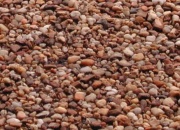Difference between revisions of "Gravel"
Jump to navigation
Jump to search
| (2 intermediate revisions by 2 users not shown) | |||
| Line 4: | Line 4: | ||
A general term used for stone aggregate ranging in size from 4 mm to 64 centimeters. Natural gravel deposits are found are found near rivers or beaches. The stones typically have rounded edges due to abrasion and weathering. [[Clay]] accumulations in the gravel can form a cemented stone called a [[conglomerate]]. | A general term used for stone aggregate ranging in size from 4 mm to 64 centimeters. Natural gravel deposits are found are found near rivers or beaches. The stones typically have rounded edges due to abrasion and weathering. [[Clay]] accumulations in the gravel can form a cemented stone called a [[conglomerate]]. | ||
| − | == | + | ==Resources and Citations== |
| − | * | + | * Fred Gamble, Submitted information, October 2007 |
* ''The American Heritage Dictionary'' or ''Encarta'', via Microsoft Bookshelf 98, Microsoft Corp., 1998 | * ''The American Heritage Dictionary'' or ''Encarta'', via Microsoft Bookshelf 98, Microsoft Corp., 1998 | ||
| − | * ''Encyclopedia Britannica'', http://www.britannica.com Comment: "Gravel." | + | * ''Encyclopedia Britannica'', http://www.britannica.com Comment: "Gravel." Accessed 13 May 2004 . |
[[Category:Materials database]] | [[Category:Materials database]] | ||
Latest revision as of 10:41, 30 August 2022
Description
A general term used for stone aggregate ranging in size from 4 mm to 64 centimeters. Natural gravel deposits are found are found near rivers or beaches. The stones typically have rounded edges due to abrasion and weathering. Clay accumulations in the gravel can form a cemented stone called a Conglomerate.
Resources and Citations
- Fred Gamble, Submitted information, October 2007
- The American Heritage Dictionary or Encarta, via Microsoft Bookshelf 98, Microsoft Corp., 1998
- Encyclopedia Britannica, http://www.britannica.com Comment: "Gravel." Accessed 13 May 2004 .
